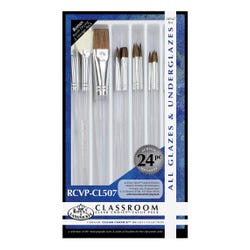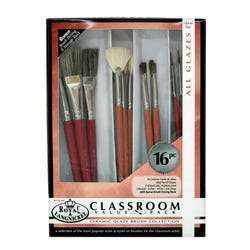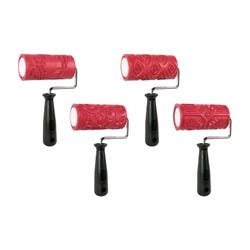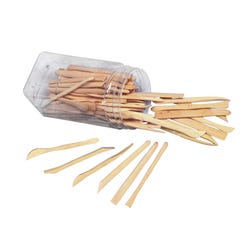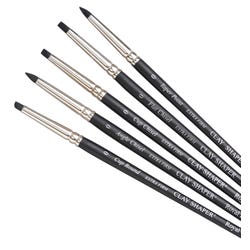Facade Bud Vase (It's Greek to Me!)

Description
Lesson Plan and Artwork by Eric Orr
The invention of the pottery wheel enabledearly potters in many countries to easily create functional and ceremonial pottery. Greek potters molded pots of various sizes and shapes to hold and transport water, wine and olive oil. Potters often joined with painters who decorated their pots first with geometric bands, and later with red and black slip figures.
Objectives
- Become acquainted with various classical Greek.
- Translate 3-D pottery forms into 2-D shapes.
- Impress natural forms into rolled out vase shapes.
- Join the pot shapes to a textured slab tube in orderto create a functional bud vase with a pot "facade"or false front.
Supplies Needed
AMACO® Versa Clay, White 20, 50 lbs
AMACO® Tile Cutter with Handle, 4"
AMACO® Clay Slabmaking Complete Kit
AMACO® Koi Fish, Leaf Tribal, Pre-Columbian Clay Rollers, 4 1/2", Set of 4
AMACO® Teacher's Palette Glaze Class Pack, 8 oz, Set of 12
Kemper Fettling Knife, 4 1/2" long
Royal® & Ceramic Glaze Brushes Value Pack, Assorted Sizes, Set of 16
Sax® Boxwood Modeling Tool Set, Assorted Tools, Set of 72
Color Shapers Small Clay Modeling Tool Set, Black, Size 0, Set of 5
*Here are the supplies needed for this lesson plan for reference. Find a convenient carousel of shoppable products for this lesson below.
Standards
Creating
Anchor Standard #1: Generate and conceptualize artistic ideas and work.
Anchor Standard #3: Refine and complete artistic work.
Presenting
Anchor Standard #5: Develop and refine artistic work for presentation.
Responding
Anchor Standard #8: Interpret intent and meaning in artistic work.
Connecting
Anchor Standard #11: Relate artistic ideas and works with societal, cultural and historical context to deepen understanding.
Instructions
1
Draw several Greek pottery shapes: A. An OLPE is a Corinthian flask or pitcher used for oil or other liquids. B. An AMPHORA is a jar for carrying water or wine (phorein=to carry). C. A LEKYTHOS is a cylindrical (olive) oil bottle. Choose one and create a template on tag board or other heavy paper. The easiest way is to fold thepaper like you are cutting a valentine and draw half the pot on the template. Cut it out. The size of your cut-out shape will be the size of your front pot facade (5-8" tall).
2
Roll out a clay slab to 1/4" thickness with 1 lb. of clay (apple-sized ball). Set the template on the slab and cut out your pot-shaped slab with pin tool or fettling knife.
3
Allow slab to firm up a bit and roll out another 1/4" slab bigger than 5" x 6". Using a textured roller, roll a texture onto the slab and cut into a 5" x 6" rectangle. This is your tubular cylinder for bud vase.
4
Using a plastic, 4" x 1 3/4" diameter piece of PVC pipe (or other tube), cover with newspaper so the clay rectangle will not stick to the pipe.
5
Roll the rectangular-textured slab around the tube, score and slip the seam and then smooth the joint.
6
Place a bottom on the tube and score and slip it. Make sure it will not leak.
7
Find small flowers, weeds, herbs or grasses and roll them onto the first pot-shaped rectangle of clay with roller. Do not choose plant material that is too thick as it will go all the way through the slab when rolled.
8
Score and slip a narrow vertical portion of the cylindrical tube as well as the center back of the pot facade slab. Press together to form your facade bud vase.
9
Dry, bisque fire at cone 04 (1949 degrees F.)
10
Glaze with AMACO® Teachers Palette glazes. They are bright, opaque and mixable.
11
Tip, dry foot bottom (wipe off glaze) or coat with an underglaze as underglazes have no silica (glass) so it will not stick to kiln shelf.
12
Glaze fire to cone 05 (1888 degrees F.)




